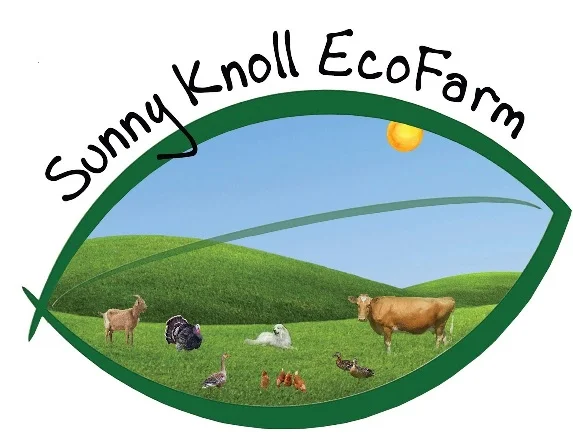We’re taking a rest from vegetables for CSA right now, so we are not offering the CSA in 2024.
Vegetable and Fruit CSA
We personally try to eat a healthy diet that is as close to the land as possible, environmentally friendly, and part of our integrated farm ecosystem. We grow around 100 different kinds of vegetables, fruits, and mushrooms on about an acre of gardens, orchards, fence rows, and edible forest landscaping. This production is primarily for personal use, but we have a bounty of wonderful fruits and vegetables now. After establishing everything over the past nine years, we now have enough to offer CSA boxes to a limited number of members.
We focus intently on environmental stewardship. We are very proud to have now completely eliminated the use of plastic as ground covering. We also work hard to package our produce without the use of any plastics. We have never, ever tilled our soil. We use sheet composting and deep mulching to create an incredibly fertile soil teeming with microbial life. Tilling the soil releases carbon into the atmosphere. Our no-till, composting, and mulching work together to sequester carbon in the soil; these practices would help to reverse climate change if done on a global scale.
Our ancestors ate an incredible diversity of plants that, sadly, many of us never get to even taste today. We are working hard to establish currently-rare crops that sustained people long ago, edible plants that are native to the Americas but uncommonly eaten today, and plants that are typically grown in other parts of the world and are nearly impossible to source locally.
Do you seek to diversify your vegetables and fruits beyond the monotonous supermarket offerings?
Do you want your food to be grown with Earth-friendly practices?
Do you delight in culinary adventures and trying new foods?
Do you find supermarket vegetables bland, poorly-textured, and uninspiring?
If you answered yes, then our vegetable and fruit CSA is for you!
One share provides about 1/2 bushel per week; you can expect to find 6-10 items in your box. The cost is $30 per week. What you’ll find in your box varies with the seasons. We attempt to have freshly picked produce year-round. In the winter we use row cover and other creative methods to keep our vegetables healthy and happy even through snow and bitter cold. Many vegetables are at their peak of deliciousness when winter-grown. You simply haven’t experienced the full potential of vegetables like kale and collards until you eat them fresh from a winter garden—they are wonderfully sweet, tender, delicious, and nutritious. We will try to keep your boxes full through the winter, but if we do have to suspend the shares in the winter, then of course you won’t pay again until vegetables are available in the spring. You can cancel at any time, but we ask for 30 days notice to cancel. If you would like a mini-share, please ask us. Contact sarah@sunnyknollecofarm.com to sign up.
Typical Winter Garden Harvest, from Late December
Typical Summer Garden Harvest, from August
We have around 100 different plants growing on our EcoFarm. Some produce reliably for many months of the year (4 stars), some are in season for just a few weeks (2 stars), and others are highly seasonal and may be available for only one week of the year. Others are planted but not yet producing, or produce sporadically depending on weather variables; these we consider in development and hope to have reliably available soon (no stars).
Agaracus Wild Mushroom
Apple
Apricot
Arugula**
Asian Long Beans****
Asparagus*
Basil****
Beets, both root and tops****
Black Raspberry*
Blackberries*
Blewit Mushroom
Blue Foot Mushroom
Blueberries**
Boysenberries*
Broccoli*
Brussel Sprouts
Cabbage*
Canteloupe*
Carrots**
Cauliflower*
Celeriac
Celery*
Chard****
Cherry
Chestnut
Chicory
Chinese cabbage*
Chives****
Cilantro****
Collards****
Cucumber****
Dandelions, greens, buds, flowers, roots**
Dill****
Dragon Tongue Beans****
Eggplants, white and purple****
Elderberry, both flowers and fruit****
Fennel*
Fiddlehead
Fig
Garlic****
Grape
Green Beans****
Hakuri turnips****
Highbush Cranberry*
Honeydew
Hubbard Squash
Jujube**
Kale, multiple heirloom varieties****
Kiwi
Kohlrabi**
Lettuce****
Lima Beans*
Locust Flowers*
Marshmallow
Mint*
Morrel Mushroom
Mulberries****
Nasturtium, edible flowers and leaves****
Nectarine
Okra****
Onions****
Oregano****
Oyster Mushroom
Parsley**
Parsnips
Pawpaw**
Peach
Pear
Peppers****
Persimmon*
Plum
Pomegranate
Potatoes****
Pumpkins**
Purple Sprouting Broccoli****
Quince
Radishes****
Ramps*
Raspberries**
Redbud Flowers*
Rhubarb*
Rose, edible flowers and rose hips****
Sage****
Salsify
Scallop squash****
Serviceberry*
Snap peas****
Spaghetti Squash**
Spinach****
Strawberries**
Summer savory**
Sweet corn, several varieties**
Sweet Potatoes, both roots and greens****
Thyme**
Tomatoes, many heirloom varieties****
Watermelon**
Winecap Mushroom
Yellow Crookneck Squash****
Zuchinni****


